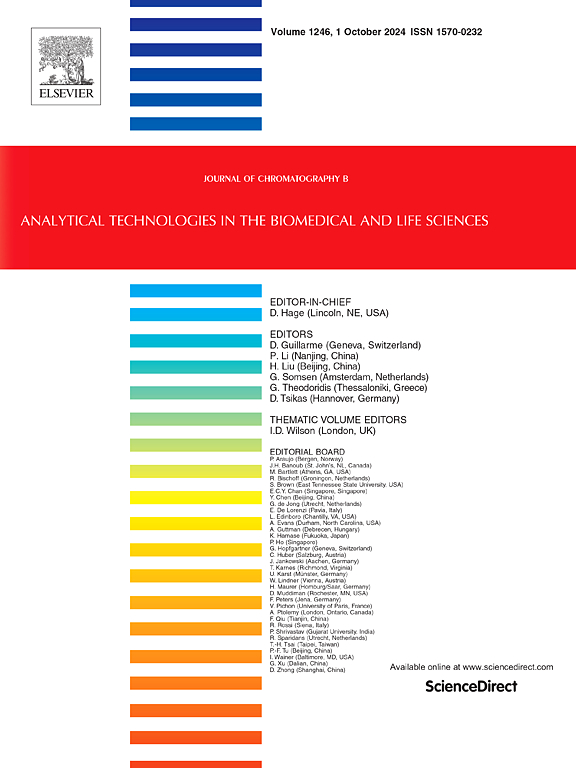超大孔低温凝胶膜经聚乙烯亚胺辅助装饰有效去除细菌内毒素
IF 2.8
3区 医学
Q2 BIOCHEMICAL RESEARCH METHODS
引用次数: 0
摘要
内毒素是革兰氏阴性菌死后细胞壁释放的高致病性毒素,可导致败血症和肠道炎症等危重疾病。采用聚甲基丙烯酸2-羟乙基(HEMA)-甲基丙烯酸缩水甘油酯(GMA)/聚乙烯亚胺(PEI)低温凝胶膜固定PEI溶液,制备了用于内毒素去除的聚甲基丙烯酸2-羟乙基(HEMA)-甲基丙烯酸缩水甘油酯(GMA)低温凝胶膜。处理过的PEI%溶液浓度、内毒素溶液浓度和环境温度影响聚HEMA-GMA低温凝胶膜的内毒素结合率。用25% PEI溶液在25°C下处理poly(HEMA-GMA)低温凝胶膜,观察到最大的内毒素去除。此外,poly(HEMA-GMA)/PEI低温凝胶膜随着内毒素浓度的升高而表现出增加的内毒素结合。在水溶液和人工血浆介质中,低温凝胶膜结合的内毒素百分比随着溶液中内毒素浓度的增加而增加。鲎试剂(LAL)测定结果表明,人工血浆和水溶液中结合内毒素的百分比大致相等。所制备的聚HEMA-GMA /PEI吸附剂具有良好的可重复使用性和对内毒素的去除能力。Langmuir吸附等温线模型可以准确地描述吸附过程。本文章由计算机程序翻译,如有差异,请以英文原文为准。

Supermacroporous cryogel membranes via polyethyleneimine-assisted decoration for efficient removal of bacterial endotoxin
The endotoxin, which is a highly pathogenic toxin released from the cell wall of gram-negative bacteria after death, can lead to critical diseases such as sepsis and intestinal inflammation. Poly 2-hydroxyethyl methacrylate (HEMA)-glycidyl methacrylate (GMA)/polyethyleneimine (PEI) cryogel membranes employed for endotoxin removal were synthesized via the immobilization of PEI solution with poly(HEMA-GMA) membranes. The concentration of the treated PEI% solution, the concentration of the endotoxin solution, and the ambient temperature influenced the endotoxin binding percentage of poly(HEMA-GMA) cryogel membranes. Maximum endotoxin removal was observed with poly(HEMA-GMA) cryogel membranes treated with a 25 % PEI solution at 25 °C. Additionally, it was noted that poly(HEMA-GMA)/PEI cryogel membranes exhibited increased endotoxin binding with rising endotoxin concentrations. The percentage of endotoxin bound by cryogel membranes in both aqueous solutions and artificial plasma media increases with the endotoxin concentration in the solutions. The Limulus Amebocyte Lysate (LAL) assay results show that the percentages of bound endotoxin in artificial plasma and aqueous solutions are approximately equivalent. The prepared poly(HEMA-GMA)/PEI adsorbent exhibited good reusability and offered high removal ability for endotoxin. The adsorption process can be accurately described by Langmuir adsorption isotherm model.
求助全文
通过发布文献求助,成功后即可免费获取论文全文。
去求助
来源期刊

Journal of Chromatography B
医学-分析化学
CiteScore
5.60
自引率
3.30%
发文量
306
审稿时长
44 days
期刊介绍:
The Journal of Chromatography B publishes papers on developments in separation science relevant to biology and biomedical research including both fundamental advances and applications. Analytical techniques which may be considered include the various facets of chromatography, electrophoresis and related methods, affinity and immunoaffinity-based methodologies, hyphenated and other multi-dimensional techniques, and microanalytical approaches. The journal also considers articles reporting developments in sample preparation, detection techniques including mass spectrometry, and data handling and analysis.
Developments related to preparative separations for the isolation and purification of components of biological systems may be published, including chromatographic and electrophoretic methods, affinity separations, field flow fractionation and other preparative approaches.
Applications to the analysis of biological systems and samples will be considered when the analytical science contains a significant element of novelty, e.g. a new approach to the separation of a compound, novel combination of analytical techniques, or significantly improved analytical performance.
 求助内容:
求助内容: 应助结果提醒方式:
应助结果提醒方式:


